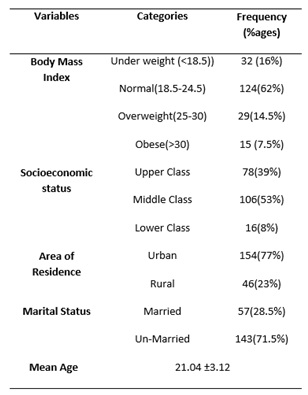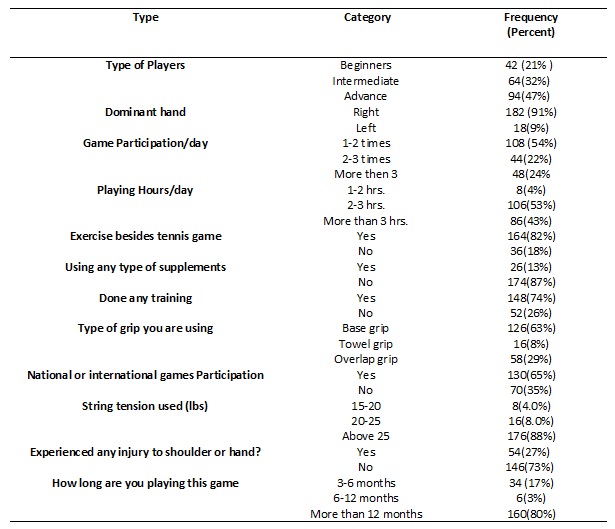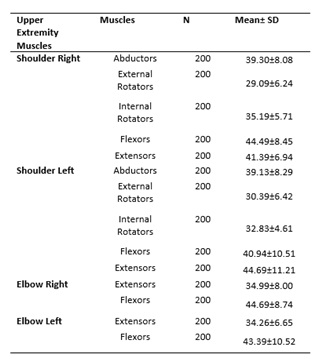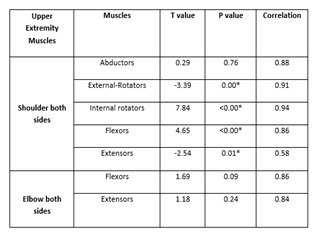ABSTRACT
BACKGROUND AND AIM
Muscular strength is an important predictor during the games among players that need to be addressed during the rehabilitation process.
METHODOLOGY
This Cross sectional–analytical study was conducted on a sample of 200 male tennis players. The data was collected using convenient sampling from Tennis players in different clubs of Lahore. Hand held dynamometer was used to measure the strength. SPSS version 21.0 was used for data analysis.
RESULTS
The current study consists of 200 male tennis players having mean age 21.04 ±3.12 years. The results showed difference between both sides muscular strength with a statistically significant difference (p value 0.0) between strength of external rotators of left and right shoulder and internal rotators and flexors (p value <0.001) respectively. The extensors strength was statistically significant (p value 0.014) respectively. There was strong correlation between abductors, right and left external rotators, internal rotators of right and left flexors of shoulder in tennis players (r=0.86)
CONCLUSION
The strength of upper limb muscles, including right shoulder internal rotators, right elbow flexors, left shoulder abductors, left shoulder internal rotators and left elbow flexors were stronger among tennis players.
KEY WORDS
Hand Held Dynamometer, upper Extremity, Muscles, Strength, Tennis Players, Upper Extremity.
Ali Shehvaiz Younas
Physical Therapist
Reactive Physio Clinic, Lahore
ORCID ID: 0000-0002-5465-4902
Waqar Afzal
Assistant professor
University Institute of Physical Therapy, The University of Lahore
ORCID ID: 0000-0001-5496-5949
Tahir Mahmood
Senior Lecturer/Physical Therapist
Imran Idrees Institute of Rehabilitation Sciences
Sialkot Medical College
ORCID ID: 0000-0003-0175-5248
Muhammad Mubashir
Physical Therapist
Reactive Physio Clinic, Lahore
ORCID ID: 0000-0002-3188-3198
Faheem Abbas
Physical Therapist
Reactive Physio Clinic, Lahore
ORCID ID: 0000-0002-0788-5273
[Younas AS, Afzal W, Mahmood T. et al.Quantitative Comparison of Right and Left Upper Extremity Muscles Strength among Tennis Players through Dynamometer
Pak.j.rehabil. 2022; 11(1):128-135]
DOI: 10.36283/pjr.zu.11.1/016
INTRODUCTION
Sports players develop endurance in their field of play as they use their upper extremity in different positions as in tennis game including hopping, hitting, stroking and curving with receptive ability1. Muscular strength is defined as the ability of a muscles to apply force on an external environment or resistive force2.A large numbers of factors may contribute regarding the performance of the players3. While scientists cannot manipulate genetics of the players, all they work is on the muscular power of the athlete to enhance their performance. Tennis is such sports activity in which players shift their positions abruptly and use their muscles in multiple directions4. Tennis players success is related to multiple factors including psychological, technical factors, tactics of the players and most importantly the strength of the muscles4.In this game due to increase demand of physical activity the rate of injury also increases and injuries of ankle, elbow joint, and shoulder joints are also common. Most specifically the injury involving shoulder muscles i.e. 75% that’s why the shoulder injuries lead to instability of the joint resulting lack of coordination among the players6 The muscular strength is commonly assessed using reliable and an easily available device , which is considered as gold standard tool and mostly used by the researchers is the – Hand held dynamometer (HHD)7 Despite of age factor or gender, the use of muscles is related to muscular strength development and its decline2. Such observations give additional osteogenic capability of standard tennis interest and show a positive relation with muscular strength and bone size. But the agonist /antagonist muscle action in upper extremity enables estimation of muscles and bone adjustments3.Taking everything into account, this investigation underscores that shoulder torment in the playing arm is a typical side effect in recreational players. Despite the fact that the agony causes issues, the players used to play with knowledge of facts about adverse effects of muscular imbalances yet playing with on-going side effects4.
This examination upheld present information of a connection among muscle quality, bulk, and bone thickness. The investigations shows that playing tennis initiates neighborhood mechanical strains on the predominant lower arm, increasing bone size at the dominant side. The end to end distinction might be incompletely clarified by muscle compressions. The approximation of getting ready power would have enabled a predominant perception of the unpredictable segments interfacing the biomechanical components to bone growth.(5) Various factors can be considered while regarding the fitness or physical capacity of the tennis players ,including age , maturity and body size and present level of health as key determinant of the muscular strength.(12)The commitment of either factor might be identified with the multidimensional nature of the activity task utilized during preparing. The reason for this examination was to gauge how much muscle hypertrophy adds to gains in strength during activities of shifting multifaceted nature. This study was aimed to measure muscle strength with use of dynamometer due to lack of data in population of study. This study may be helpful for the trainers.
METHODOLOGY
Study Design: This cross-sectional study was conducted in clubs of Lahore.
Duration The duration of study was from July 2020 to January 2021. The ethical approval was taken from the University of Lahore. (IRB-UOL-FAHS/730-2020)
Inclusion and Exclusion: The male tennis players in age range of 16 to 40 were included. The players with any type injury, surgery, Systemic disease and musculoskeletal disease were excluded.
Sample size: Sample size of 200 was determined by utilizing formulae: n=(Z1-β+Z1-α/2)2+((δ1+ δ2))/(μ1-μ2)2 α=0.05, µ1=37.16, µ2=39.30, δ1=6.23, δ2=8.09, β=0.20.13
Sampling Technique: The convenience sampling was used for data collection from participants.
Outcome Tool: Players were assessed for Muscular strength and it was measured in lbs. using dynamometer, which has (r=>0.91) while inter tester and intra-tester reliability was excellent for all movements (at ICC >0.85,present in literature. (6)
Data Collection procedure: The result of muscle force and contraction velocity is said as muscular strength which is an essential part of rehabilitation and dealing with muscular weakness, injuries and strength training. (7) Before the data collection an informed consent was signed by participants. The muscle strength was assessed in lying, and were participants were asked to push with available force in different plots, as per required muscle movement to confirm the specificity of muscle. (8)
We have assessed major muscles of elbow and shoulder of both sides. The data was analyzed through SPSS version 21. BMI was categorized in underweight, normal, overweight, and obese. (17) Self -administered questionnaire was used to collect demographic data/information about participants for sort of game, dominant hand, gaming hour.
Ethical Considerations
After complete elaboration of study purpose and details of data confidentiality, the participants were asked for informed written consent. The data confidentiality was maintained, and privacy and disclosure of patient identity was well protected.
Data Analysis
All subjective information was presented as mean ± S.D and frequency of basic details was presented in tabulated form, independent t –test was used for measuring the outcomes of interest and Pearson correlation for comparison of strength. The p value was taken as <0.05 as significant.
RESULTS
The present study comprised of male tennis players having mean age 21.04 ±3.12 years. Most of the participants (62%) in normal BMI, while 16% were in underweight category BMI.
Table No: I Demographic detail of Participants

Among the participants, there were n=182 responded that they were right hand predominant. (Table No. II) The Mean strength right side flexors of elbow was more than extensors and Internal rotators of shoulder strength for in tennis players was more (35.19±5.71 lbs.) than external rotators. (Table. No. III)
Table No: II Characteristics of Participants

Table. No III Muscular strength of Upper Limbs among Participants

The strength of extensors of right and left shoulder in tennis players was statistically significant (p value 0.01) but not statistically significant (p value 0.09) between flexors of right and left elbow and extensors of right and left (p value 0.24). The difference in strength was found as a weak correlation was found among shoulder muscles of both sides but strength of Elbow muscles, strong correlation(r=0.86) exists between flexors and extensors of elbow among tennis players (r=0.84) (Table No. IV) P < .05 was significant (at 95% CI) *= Significance.
Table No. IV Independent t-Test Results and Correlation

DISCUSSION
This study was directed to check the correlation of upper extremity strength of tennis players through dynamometer. The mean age was 21.04 ±3.12. Muscular strength was measured in lbs. Results stated that strong correlation exists between both sides of abductors, external rotators, internal rotators and flexors, but weak correlation exists among extensors of shoulder. In elbow strong correlation was found in both side’s flexors and extensors.
The study of Anna Suza , Right side shoulder abductors, extensors, flexors were strong compared to their counter parts, and an estimated bilateral difference between right and left side was observed. The difference was also noted in right side elbow flexors at mean of 25.34±3.96 and for extensors 23.90±6.99, and for left elbow flexors 21.58±5.82 and extensors 26.10±8.56, showing a big difference in left side. (9) The physical training of tennis players in combination with strength training is associated with physical capacity leading to increased endurance level of the players. (19) But in our study Abductor right side of shoulder were strong in tennis player (39.30±8.08 lbs), While Internal rotators strength right side of shoulder in tennis players was more (35.197±5.71lbs) than external rotators. But this strength was quite different from study of Anna Suza. Similarly, Mean Flexors, extensors, rotators of both shoulder were having good strength. There was slight differences noted but these results were in contrast to this study. Comparing to this study, Mean of Flexors strength right side and left side of elbow in tennis players were stronger (44.69±8.74) than their counter extensors strength (34.99±8.00). The study in 2015 among tennis players stated that both sides of shoulder have high strength despite of dominant or non-dominant hand. But internal rotators strength was lower compared to external rotators. This was studies in two groups, in which ne group showed a significant good strength than other. Literature support that tennis players have high strength of internal rotators and can play the games. (10)The level of stiffness values can increase the stroke velocity, because the transition of power required from lower part of the body towards upper. There should be strong correlation of strength and power, because the study has proved that both of these determinants poor correlation due the strokes nature and dependency on age21.In this study statistically significant (p value 0.00) between strength of external rotators of right and left shoulder .Similarly strength of internal rotators and left shoulder in tennis players was statistically significant <0.00 respectively. Studies support that functional ratio of internal rotators concentric and external rotators eccentric have relationship that can be due to produced force in the shoulder muscles22. In our study we have 16% of the underweight and 62% sports players normal BMI category , that might had effected the muscular strength and the strength homogeneity of both sides was not correlated. The high lean body mass, found high strength but it was not associated with biological age factors. Hence it can be considered that lean players will have more strength with depending on the age or maturation23,24.
In this study we used convenience sampling technique thus it limits generalization of our results to those who have different characteristics from those of our sample for example the players with shoulder injury. The use of standard strategy would ensure further solid estimations of upper extremity strength in both examination and clinical settings as contrast with results of the investigators. The work can be further proceeded on quantifying the upper extremity in various players other than tennis players to find out the correlation among various players dependent on their games.
CONCLUSION
The muscular strength of upper limb including right shoulder internal rotators, right elbow flexors, left shoulder abductors, left shoulder internal rotators and muscles of left elbow were seen strong in the tennis players of Lahore. The overall strength of right side was dominant compared to left side.
Disclaimer: None to declare
Conflict of Interest: None to declare
Funding Disclosure: None to declare.
REFERENCES
- Ooi CH, Tan A, Ahmad A, Kwong KW, Sompong R, Mohd Ghazali KA, et al. Physiological characteristics of elite and sub-elite badminton players. Sports Sci.2009;27(14):1591-9.
- Suchomel TJ, Nimphius S, Stone MHJSm. The importance of muscular strength in athletic performance. 2016;46(10):1419-49.
- Sarlis V, Tjortjis CJIS. Sports analytics—Evaluation of basketball players and team performance. 2020;93:101562.
- López-Samanes Á, J GP, Pérez-López A, Mora-Rodríguez R, Ortega JF. Hormonal and neuromuscular responses during a singles match in male professional tennis players. PloS one. 2018;13(4):e0195242.
- López-Samanes Á, Pérez-López A, Moreno-Pérez V, Nakamura FY, Acebes-Sánchez J, Quintana-Milla I, et al. Effects of beetroot juice ingestion on physical performance in highly competitive tennis players. 2020;12(2):584.
- Sotos Martínez VJ. Influence of Fatigue on Variables of Performance in Tennis. 2020.(http://193.147.134.18/bitstream/11000/6066/1/Sotos%20Mart%C3%ADnez%2C%20Francisco%20Javier.pdf)
- Hirano M, Katoh M, Gomi M, Arai SJJopts. Validity and reliability of isometric knee extension muscle strength measurements using a belt-stabilized hand-held dynamometer: a comparison with the measurement using an isokinetic dynamometer in a sitting posture. 2020;32(2):120-4.
- Abe T, DeHoyos DV, Pollock ML, Garzarella L. Time course for strength and muscle thickness changes following upper and lower body resistance training in men and women. J. Appl. Physiol. 2000;81(3):174-80.
- Ireland A, Maden-Wilkinson T, McPhee J, Cooke K, Narici M, Degens H, et al. Upper limb muscle–bone asymmetries and bone adaptation in elite youth tennis players. Med Sci Sports Exerc 2013;45(9):1749-58.
- Fahlström M, Söderman K. Decreased shoulder function and pain common in recreational badminton players. Scand J MedSci Sports2007;17(3):246-51.
- Ducher G, Jaffré C, Arlettaz A, Benhamou C-L, Courteix D. Effects of long-term tennis playing on the muscle-bone relationship in the dominant and nondominant forearms. Can J Appl Physiol. 2005;30(1):3-17.
- Söğüt M, Luz LG, Kaya ÖB, Altunsoy K, Doğan AA, Kirazci S et al. Age-and maturity-related variations in morphology, body composition, and motor fitness among young female tennis players. Int JEnviron Res Public Health. 2019 Jan;16(13):2412.
- Chandler TJ, Kibler WB, Stracener EC, Ziegler AK, Pace BJTAJoSM. Shoulder strength, power, and endurance in college tennis players. 1992;20(4):455-8.
- Ben RC, Latiri I, Dogui M, Ben HS. Effects of one-night sleep deprivation on selective attention and isometric force in adolescent karate athletes. J Sports MedPhys Fitness. 2017;57(6):752-9.
- Romero-Franco N, Fernández-Domínguez JC, Montaño-Munuera JA, Romero-Franco J, Jiménez-Reyes P. Validity and reliability of a low-cost dynamometer to assess maximal isometric strength of upper limb: Low cost dynamometry and isometric strength of upper limb. Sports Sci. 2019;37(15):1787-93.
- Krause DA, Neuger MD, Lambert KA, Johnson AE, DeVinny HA, Hollman JH. Effects of examiner strength on reliability of hip-strength testing using a handheld dynamometer. J Sport Rehabil. 2014;23(1):56-64.
- Mahmmod T, Mahmood W, Maqsood U, Salam A, Sefat N. Level of Actual Physical Fitness and its Perception among Students of Physiotherapy in Lahore. J Liaquat Uni Med Health Sci. 2019;18(01):60-4. doi: 10.22442/jlumhs.191810602
- Zuša A, Lanka J, Čupriks L, Dravniece I. A descriptive profile of isometric muscle strength and muscle strength imbalance in young tennis players. Balt J Sport HealthSci. 2015;4(99).
- Miranda JM, Polito LF, Rica RL, Miranda ML, Bocalini DS, Figueira Júnior A. Muscle strength training and prescribing in competitive tennis players: a systematic review. Revista Brasileira de Medicina do Esporte. 2020 Feb;26(1):87-92.
- Vodička T, Zvonař M, Pačes J, Knjaz D, Ružbarský P, Zháněl J. Strength values of shoulder internal and external rotators in junior tennis players. Kinesiology. 2018;50(2):181-7.
- Colomar J, Baiget E, Corbi F. Influence of Strength, Power, and Muscular Stiffness on Stroke Velocity in Junior Tennis Players. Front Physiol . 2020 Mar 6;11:196.
- Saccol MF, Gracitelli GC, da Silva RT, Laurino CF, Fleury AM, Andrade Mdos S, et al. Shoulder functional ratio in elite junior tennis players. Physical therapy in sport : official journal of the Association of Chartered Physiotherapists in Sports Medicine. 2010;11(1):8-11.
- Almeida-Neto PF, Matos DG, Baxter-Jones AD, Batista GR, Pinto VC, Dantas M, Aidar FJ, Dantas PM, Cabral BG. The effectiveness of biological maturation and lean mass in relation to muscle strength performance in elite young athletes. Sustainability. 2020 Jan;12(17):6696.
- Younas AS, Afzal W, Mahmood T, Sharif F, Mubashir M. Quantitative measurement of upper extremity muscles strength among badminton players through dynamometer. Rawal Medical Journal. 2021 Apr;46(2):457-60.
